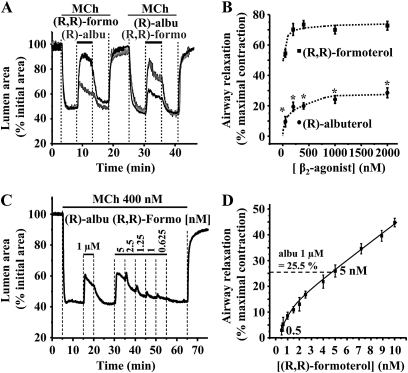Figure 3.
Comparison of airway relaxation induced by (R)-albuterol and (R,R)-formoterol. (A) Representative experiments showing the effect of (R,R)-formoterol (1 μM) and (R)-albuterol (1 μM) on the same MCh-contracted airway. (R,R)-formoterol induced a larger relaxation than the subsequent exposure to (R)-albuterol (black line). Similar results were obtained if the application order of (R)-albuterol and (R,R)-formoterol was reversed (gray line). (B) The mean concentration-dependent relaxation induced by (R)-albuterol and (R,R)-formoterol (50–2,000 nM) in airways contracted with MCh (400 nM). Relaxation induced by (R,R)-formoterol was significantly greater than that induced by (R)-albuterol (*P < 0.05; n = 4 mice for (R,R)-formoterol and (R)-albuterol). Mean (±SD) values are presented; a minimum of three experiments was performed for each concentration for each mouse. (C) Representative experiment showing the relaxant effect of (R)-albuterol (1 μM) followed by 5, 2.5, 1.25, 1, and 0.625 nM of (R,R)-formoterol on the same MCh-contracted airway. (D) The mean concentration-dependent relaxation to low concentrations of (R,R)-formoterol (0.5–10 nM). The maximal relaxation induced by 5 nM (R,R)-formoterol was 26.65 (±2.35)% (% maximal contraction; n = 5 mice; a minimum of three experiments was performed for each concentration for each mouse), which was equivalent to the relaxation induced by 1 μM (R)-albuterol.

